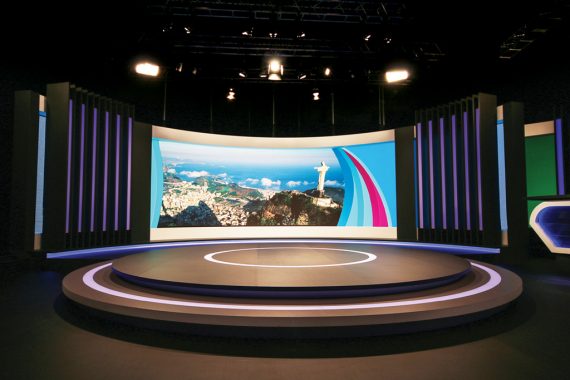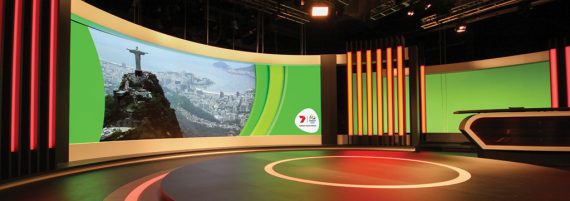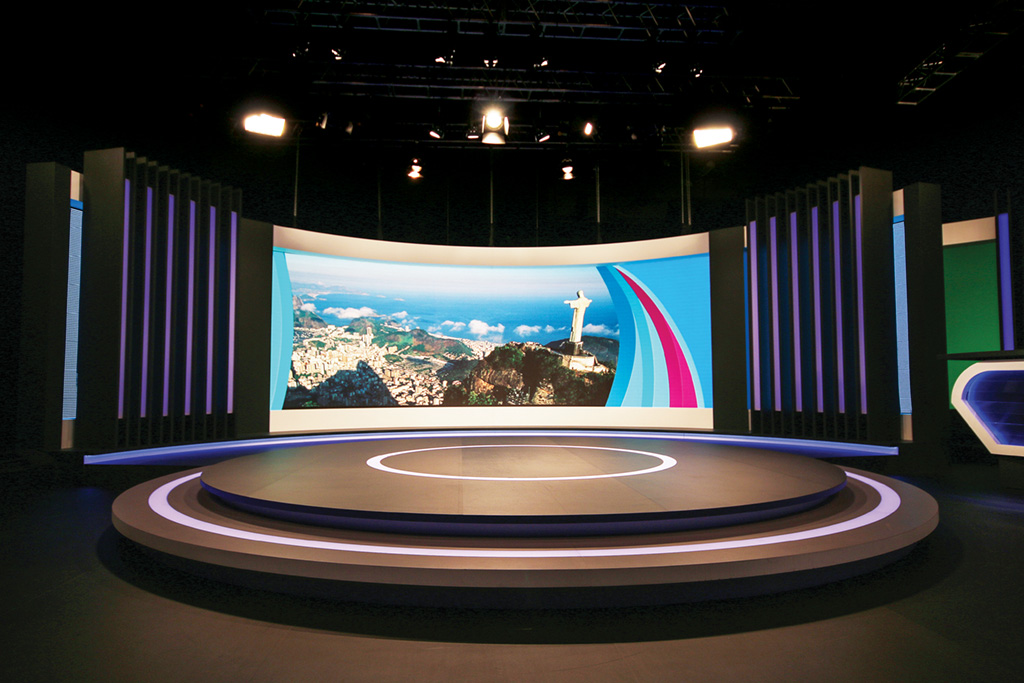
The Channel 7 host broadcast studio featured one of the finest LED screens seen in this region.
Story: Christopher Holder
A quick recap, because the Olympics seems a long time ago now. Channel 7 was the host broadcaster. Meanwhile the NEP Group was appointed by NBC Olympics to provide the mobile broadcasting and engineering consulting for its production. NEP pitched Channel 7 a design for a host broadcast studio in its Sydney facility. A key piece of the pitch was a beautiful, curved video backdrop.
Channel 7 went for it and work immediately started on building the so-called Rio Central Studio.
NEP’s Head of Production, Angus Millar, set about finding the right screen… the best screen he could lay his hands on for the set. DigitalSignage chatted with Angus on set last August during the pre-recording of one of the 7pm packages with anchor Hamish McLachlan.
STUDIO PITCH
Angus Millar: Our primary focus was to deliver a screen that would do better than any other in broadcast terms. LED screen resolution is important because the worse it is, the more patterning and effects you get on camera. So you get more artefacts, and when the cameras travels and the lens are wide, like we’re using, you end up with unusable pictures.
Our commitment to our client Channel 7 was to provide the best possible big-screen display for them and that meant going below 3mm pixel pitch, and this 1.8mm pixel pitch display from VuePix, well, as you can see, looks stunning to the eye and even better on camera.
FACE OF COLOUR
DigitalSignage: Is refresh rate important?
Angus Millar: That’s mainly overcome by using ClearScan in the cameras — fiddling around with shutter speeds until we get rid of the lines.
We’re running the 6 x HD feeds that hit the screen through a VPro colour converter, so we’re colour converting on the run. The technical director, who’s pointing the cameras, is also colour-correcting the screen on the run. It means that when we’re putting faces on the big screen — say, we’re doing a live cross to Bruce [McAvaney] in Rio — we can colour-correct for skin tone.
DigitalSignage: Colour is obviously an important consideration in a broadcast screen?
Angus Millar: Gamma and colour management is a bit of a dark art, and there are people dedicated to it, looking at the camera images and painting them and exposing them — that’s real-time, live, base band video being processed. It’s a big deal getting faces matching — the face of the host matching the face that’s on the screen.
DigitalSignage: How different is lighting a TV broadcast set when you have a screen like this?
Angus Millar: Our lighting director arrives at a particular colour temperature and we set the cameras for that. There are some adjustments in the software in the screen, so we find the colour temperature in the screen that works best. You can’t necessarily match the numbers and think they’ll line up. A lot of it’s done by eye on the line-up monitors until you find the right setting. Then we just leave it up to the actual colour-correcting units once we’ve got the right colour temperature in the screen and it’s looking good.
FINDING THE BEST
DigitalSignage: There are a lot of impressive LED screens out there at the moment. So you were a little bit spoilt for choice I suppose?
Angus Millar: This was the best possible screen we could get hold of in the country. At the time no other provider could give us a sub-2mm or even sub-2.5mm LED screen. So ULA and VuePix was really the only option for us to deliver what we wanted for Channel 7, which was completely pristine HD images — well, images we could shoot with an HD camera without showing up the resolution of the screen.
DigitalSignage: Screen brightness not a big concern in a dark studio?
Angus Millar: It’s running at 30% brightness, so this screen’s got a lot of power to go. Once we found the right lighting level, the screen brightness was set so the exposure worked. That’s where we landed.
DigitalSignage: And reliability?
Angus Millar: It’s been very, very solid and it’s been on the entire time; the screen’s been powered up for three weeks solid.
CURVACEOUS
DigitalSignage: How was the screen assembled?
Angus Millar: One of the first questions we put to ULA [VuePix distributor] was: “can you make the screen conform to this very tight radius?” The smaller the pixel pitch, the harder it gets, because the pixels can end up touching each other when you bend them in. Nathan [Wright] and the ULA team had to do the testing and they also came up with some bespoke bits of engineering to bolt them together.
The actual assembly and hanging of the screen was very delicate; it took a lot of time. Because the pixels themselves are so tiny, they’re very delicate and if you push too far you’ll pop a pixel. It took a couple of days. Painstaking.
DigitalSignage: How do you calibrate a curved screen like this?
Angus Millar: With a DSLR and a laptop. It took a guy to point the camera at the cabinets and find any hotspots and deal with them.
DigitalSignage: What happens if a panel did go down?
Angus Millar: The power supplies are hot-swappable. Replacing front LEDs is harder but it can be done.
AUGMENTED GRAPHICS
DigitalSignage: How does the augmented reality graphics work?
Angus Millar: The system is now called Avid Graphics — used to be called Orad Systems before Avid bought them. They can provide a system that feeds the big screen, does the standard broadcast graphics and does the augmented reality objects we put in the foreground. So it’s one, big graphics engine that feeds the screens.
DigitalSignage: Has it worked as expected?
Angus Millar: It was very, very hard getting it all functioning correctly. The software is very bespoke but once it’s on the screen it displays beautifully.
DigitalSignage: It’s like choreography isn’t it, the host has to virtually interact with the onscreen graphics.
Angus Millar: That’s why we’ve got so many monitors, the host has to see if there’s an augmented object in front of them; the host has to see everything so they can think: “Oh yeah I’m pointing at this thing that isn’t physically there”.

SCREEN SPECS
The VuePix S series features ‘black LEDs’, designed to provide a superior HD image with high contrast, deep blacks and vibrant colours. The slim design with advanced ventilation doesn’t require any fans for cooling, making the screen well suited to delicate installations like TV studios, where noise levels need to be kept to a minimum.
The NEP screen consisted of 80 panels in a 16 x 5 configuration, making it almost 7.5m long and 2.3m high. With the native resolution of over 4000 pixels horizontally and 1280 pixels vertically — 5.2 million pixels in all.
ULA (VuePix): 1300 852 476 or sales@ulagroup.com

